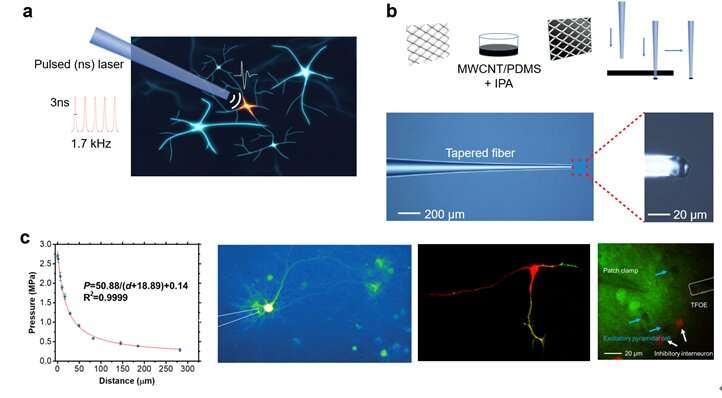
Neuromodulation at high spatial resolution is crucial for advancing understanding of brain circuits and treatment of neurological diseases. Here, a tapered fiber optoacoustic emitter (TFOE) is developed for stimulation of single neurons and subcellular structures. The TFOE enabled integration with patch clamp recording and unveiled cell-type-specific response of excitatory and inhibitory neurons to photoacoustic stimulation. TFOE provides a non-genetic single-cell and sub-cellular modulation platform, which could shed new insights into the mechanism of ultrasound neurostimulation.
Neuromodulation at high spatial resolution has been an invaluable approach for treating neurological diseases and advancing fundamental knowledge in the field of neuroscience, a the firing of a small population or even single neurons can specifically alter animal behavior or brain state. Optogenetics is a powerful method capable of modulating population neural activity in rodents, yet its requirement for viral transfection limits its applications in nonhuman primates and humans. As a rapidly growing modality, focused ultrasound has been harnessed in a myriad of brain neuromodulation applications. However, conventional piezo-based transducers offer a spatial resolution of several millimeters. It is also challenging to directly measure electrophysiological response of cells under ultrasound stimulation using whole-cell patch-clamp electrophysiology, which is the gold standard technique for high-fidelity analysis of the biophysical mechanisms of neuromodulation. New strategies with essential capabilities, including single and subcellular precision and integration of single cell electrophysiology recording, are still sought to enable the understanding of mechanical stimulation at the single cell level and to offer high precision for potential clinical applications.
In a new paper published in Light Science & Application, a team of scientists, led by Professors Chen Yang and Ji-xin Cheng from Boston University have developed a tapered fiber optoacoustic emitter (TFOE), which exploits the optoacoustic effect and generates acoustic field localized within 40 μm, for photoacoustic neural stimulation at the single cell and subcellar level. The significant advancement of TFOE in both spatial resolution and optoacoustic conversion efficiency are achieved by fiber engineering, material modification and a new deposition method. Spatially, they demonstrated acoustic stimulation with an unprecedent precision. Temporally, single acoustic pulse with duration of sub-microsecond generated by TFOE successfully activated neurons, which was found as the shortest acoustic stimuli for successful neuromodulation. Importantly, the near field acoustic wave generated by TFOE allowed optoacoustic stimulation with simultaneously monitoring cell response using whole cell patch clamp recording. Their studies revealed cell-type-specific response to acoustic stimulation for excitatory and inhibitory neurons.
Source: Read Full Article